|
Ever thought
about Louseworts ?
by
Heather
Smith
|
|
With
that common name, maybe not, but I
have, and frequently. In fact they
are one of my favourite genera when
I visit the mountains.
Of course not all Pedicularis
(to give them their proper name) are
beautiful and garden-worthy, but
some of them certainly are.
|
Pedicularis
is a circumpolar genus of the
snapdragon family (Scrophulariaceae)
consisting of perhaps 500
hemiparasitic species and we
have two species in the wild here
but neither are particularly
striking (P. sylvatica (meadow) and
P. palustra (damp ground)). They got
their common name from a belief that
the plant in the meadows somehow
gave cattle lice. Yes I know, the
suffix ‘wort’ means ‘cure’
or ‘treatment’ but farmers
thought otherwise. They are probably
quite rare because
farmers have rooted them out,
as they have Hemlock Water Dropwort.
However, herbalists use them as tranquilizers,
muscle relaxants, powerful aphrodisiacs,
and sedatives – an amazing plant
altogether.
|
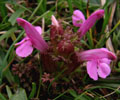 |
| P.
sylvatica |
| Rathlin
Island |
|
|
|
|
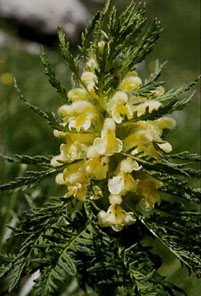 |
|
Pedicularis
foliosa |
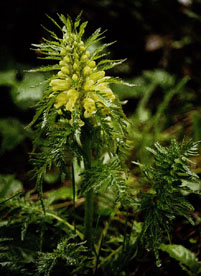 |
|
Pedicularis
hacquetia |
|
| The
first striking one that I remember
seeing was in Switzerland and, like most
people seeing one for the first time, I
thought it was an orchid. Ralph Forbes
told me that no, it was Pedicularis and
thus began my continuing love for the
genus. The species was P.
verticillata. It has rich pink
flowers and its leaves, scarlet to dark
red when it is in open ground, are
carried in whorls on the stem. At its
best, it is very eye-catching and
attractive and can frequently be seen
beside streams |
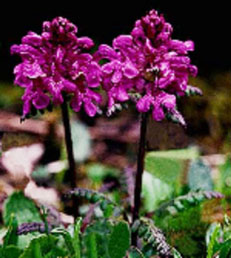
|
|
Pedicularis
verticillata |
|
|
Another
to be admired is
P. foliosa
(in the
Carpathians a
similar plant is
P. hacquetica).
This has creamy
yellow flowers
with bright
green foliage
and gets its
name from the
leaves that
extend out from
between the
flowers. Both
these species
are mid-height.
|
|
|
|
|
|
| One
of the most lovely
species is a North
American one called P.
groenlandica and
known as ‘Elephants
Heads’ for an obvious
reason. It is tall and
also likes to grow in
marshy ground or by
water in California and
the Rocky Mountains.
|
| P.
oederi is a
circumpolar species
(found all over the
northern hemisphere). A
small, upland meadow
species, the best
example of it I have
seen was in the upland
tundra of the Beartooth
Plateau in Montana, in
the Rocky Mountains, and
is the one pictured
here. It is equally at
home on a grassy slope
on Männlichen, above the
Lauterbrunnen Valley in
Switzerland or in the
Tatra Mountains in
Poland. It differs from
other species in that
all the flowers rise
from the centre of the
plant leading to it
resembling a posy.
|
|
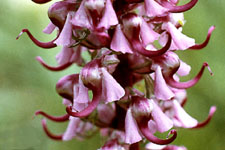 |
| P.
groenlandica |
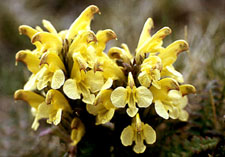 |
| Pedicularis
oederi |
|
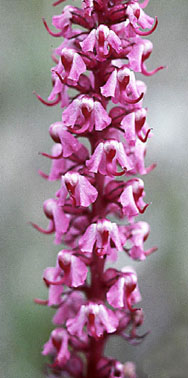 |
| P.
groenlandica |
|
|
|
|
| Small,
higher alpine species include P.
rosea and P.
kerneri both of which are
rosy pink with reddish leaves when in
the open. They are usually about 3-4
inches, have large flowers for their
height, and frequently grow on stony
ground – perhaps a candidate for the
scree. It is pictured here growing with
a young Leontopodium alpinum.
There
are many other species some of which are
very attractive. There are, naturally, a
great many I have never seen.
Of
course, if they are so all-fired
attractive why aren’t we growing them
in our gardens? Seems they are
difficult, perhaps semi-parasitic,
though no one knows exactly on what it
is parasitic. It seems that if a plant
is very attractive but is seldom seen in
cultivation, there must be some snag.
Maybe the only way to see these gems is
to go and visit them at home - their
home, that is. All the photographs are
of plants in the wild.
At the
moment I have a couple of them in the
garden and hope they survive long enough
to flower (or survive at all). Time will
tell.
|
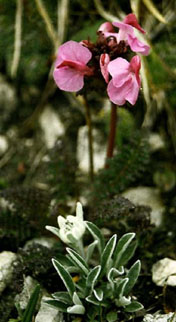 |
|
Pedicularis rosea |
|
|
|
|
|
|
|
|
